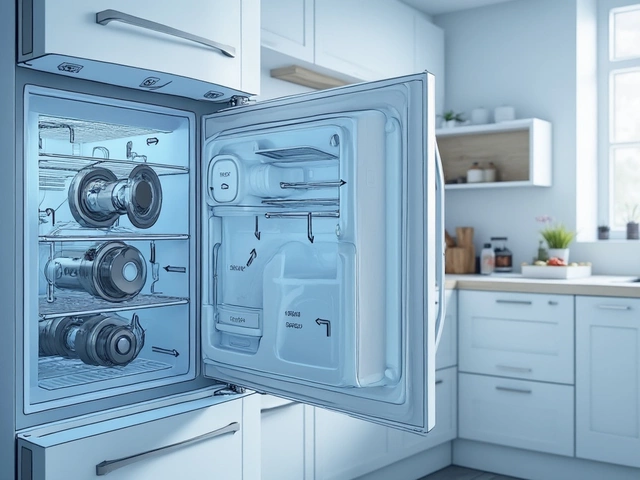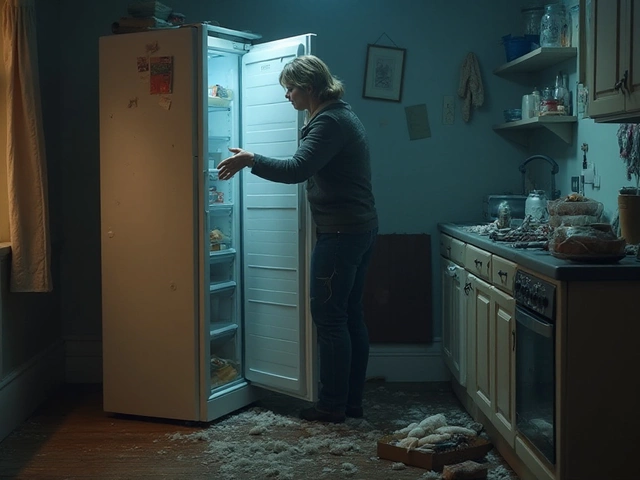If your electric oven just quit right before pizza night, you’re definitely not alone. I’ve had my own oven drama, usually a day before my son Callum’s birthday cake is supposed to come out golden-brown. The first thing most of us wonder: is it actually worth fixing this thing, or should I just start looking for a new one?
Here’s where it gets real—sometimes, a repair is the smarter move and could buy your oven a few more good years. Other times, you’re just sinking money into a gadget that’s on its last legs. The trick is knowing how to tell the difference, without spending days reading reviews or watching endless YouTube tutorials.
The costs for electric oven repair can swing wildly. Swapping out a broken heating element might run you $50 to $150. But if the control board is shot, now you’re looking at $200 and up—sometimes more than half the price of a decent new oven. And let’s not forget the cost of a technician’s time; a single visit can be $100, even if they just reset your breaker and leave.
- Red Flags: When Ovens Act Up
- Common Fixes and What They Cost
- When Repair Makes Sense
- Signs It’s Time to Replace
- DIY or Call a Pro?
- How to Stretch Your Oven’s Life
Red Flags: When Ovens Act Up
Your oven usually tells you something’s off well before it totally gives up. Catching these signs early can stop a small issue from turning into a huge headache—and even save you money on electric oven repair. Here are the most common signals that your oven needs attention:
- Uneven cooking: If your pizza comes out black on one side and doughy on the other, that’s a classic sign the heating element or thermostat is struggling.
- No heat at all: Sometimes it’s as simple as a tripped breaker, but often it points to a dead heating element or a bad control board.
- Strange smells or smoke: A bit of burning cheese is normal. Persistent smoky smells or burning plastic? That means something electrical or mechanical could be failing inside your oven.
- Faulty controls or display: Flashing error codes or unresponsive buttons are not just frustrating—they usually signal a failing control panel or wiring issue.
- Doors that won’t seal: If heat escapes or the door won’t shut tight, you’ll burn more energy and get way worse results.
- Unusual noises: Clicking, buzzing, or grinding isn’t normal. These sounds often mean something's loose or failing inside, like a fan or timer motor.
According to appliance techs in the UK, temperature problems (like not heating or inconsistent baking) are the top reason folks call for oven repair. Here’s a quick snapshot from their service logs:
| Oven Issue | % of Service Calls |
|---|---|
| Not Heating Up | 34% |
| Uneven Cooking | 22% |
| Faulty Controls | 18% |
| Strange Noises or Smells | 14% |
| Poor Door Seal | 12% |
If you spot any of these red flags, don’t just cross your fingers and hope for the best. Tackling problems early can mean you only need a simple part replaced, not a whole new oven.
Common Fixes and What They Cost
Ovens seem simple until something stops working. The truth is, most electric oven repair jobs fall into a handful of categories—some easy on your wallet, and some not so much.
The number one issue? Heating problems. If your oven isn’t getting hot, a busted bake or broil element is the usual suspect. Swapping out a heating element is one of the cheapest fixes, usually costing between $50 and $150 when you factor in parts and labor. This is often a quick job for a technician, sometimes done in under an hour.
Next up: faulty sensors or thermostats. If your lasagna always takes way longer (or shorter) than the recipe says, your temperature sensor is probably off. Sensors average $100–$200 to replace, parts and labor included. Thermostats are in the same range. Not the end of the world, but it adds up fast if you’re repairing an older oven that’s out of warranty.
The repair that really makes folks hesitate is a broken control board. This is the digital brain behind most newer ovens. When it goes, the display can flicker, buttons stop working, or the oven just won’t turn on. Fixing or replacing a control board can run from $200 up to $400 (or more if your model is fancy or uncommon). That’s a big chunk—sometimes nearly half the price of a brand-new mid-range oven.
Other fixes that come up a lot for appliance repair techs:
- Door seal replacement: If heat keeps escaping, a new gasket is $50–$75 installed.
- Igniter replacement (for hybrid or gas ovens): Usually under $150.
- Fuse or wiring issues: Minor repairs can be $75–$150, but major electrical damage—especially from power surges—gets pricey fast.
Here’s a quick breakdown for the most common oven maintenance jobs:
| Repair Needed | Average Cost |
|---|---|
| Heating Element | $50–$150 |
| Temperature Sensor | $100–$200 |
| Control Board | $200–$400 |
| Door Seal/Gasket | $50–$75 |
| Minor Electrical Fixes | $75–$150 |
Parts for older models might cost more since they're hard to find, and labor costs vary by area. If your oven is a newer or common brand, these fixes stay on the lower end of the range. For rare or really old ovens, prepare for a bigger bill—and a few days of hunting for the right part.
When Repair Makes Sense
Sometimes, going for electric oven repair just makes financial sense. For example, if your oven is less than ten years old and otherwise runs well, a small repair usually costs way less than a replacement. Most electric ovens last 13 to 15 years, with a little bit of love and the occasional swap-out for a worn part.
Here’s when it’s almost always worth repairing:
- The issue is simple, like a busted bake element, worn-out door seal, or a bad thermostat.
- The repair bill is less than half the price of a basic new oven.
- Parts are easy to find—think knobs, lights, heating elements, or racks.
- There’s no funny smell, sparking, or signs the oven’s wiring is failing—those are signals things might be more dangerous (and expensive).
Check out how the numbers line up on common fixes:
| Problem | Typical Repair Cost |
|---|---|
| Heating Element | $75 - $150 |
| Thermostat | $100 - $200 |
| Door Seal | $30 - $75 |
| Igniter (if gas-electric hybrid) | $100 - $250 |
If your oven is a decent brand—think Whirlpool, GE, or Bosch—their parts usually hang around in the market for a while. So getting a appliance repair tech to help doesn’t mean weeks of waiting.
I always compare the repair cost to what I’d have to shell out for a new oven. If you’re looking at a $100 repair job for an oven that’s otherwise reliable, that’s a no-brainer. But if you paid $550 for it five years ago and now a $300 fix pops up, it’s time to step back and think.

Signs It’s Time to Replace
Sometimes, no matter how much you want your trusty oven to rally, repair just doesn’t make sense. Here are clear signs it’s better to shop for a new one than pour more cash into electric oven repair:
- Your oven is 10-15 years old or older. Electric ovens usually last about a decade, give or take. If yours is pushing 15, it’s living on borrowed time—even if you fix today’s problem, something else could go wrong soon.
- Repair costs are over half the price of a new oven. Let’s say a new mid-range oven costs $600. If your repair quote is $300+, you’re throwing money after an aging appliance that might break again soon.
- It has repeated breakdowns. If you’ve called in a pro twice in one year, it’s time to stop patching it up.
- Parts are hard to find or discontinued. When you can’t get parts without deep internet hunting or calling the manufacturer’s secret hotline, future repairs aren’t going to get easier—or cheaper.
- It’s become unsafe. Burning smells, electrical flickers, or tripped breakers are red flags. Safety comes first—don’t risk a kitchen fire just to squeeze out one more batch of cookies.
For a bigger picture, here’s a simple look at how repair costs stack up against oven age, based on appliance service data:
| Oven Age | Avg. Repair Cost | Worth Repairing? |
|---|---|---|
| 0-5 years | $120 | Usually |
| 6-10 years | $190 | Sometimes |
| 11+ years | $250+ | Rarely |
One more thing: newer ovens use less electricity and have features older models can’t touch. If you’ve been eyeing a self-cleaning oven or want digital controls, now’s a perfect excuse to upgrade.
DIY or Call a Pro?
So, your oven’s on the fritz and the pressure’s on to get it working again. The truth is, not every issue needs a paid professional. Sometimes, a little confidence and a Phillips screwdriver go a long way. But there’s a big difference between fixing a bad heating element and tackling a faulty control board—one’s safe for beginners, the other’s definitely not.
Let’s break it down: if your oven isn’t heating up at all, check your circuit breaker first. It’s free and takes two minutes. If that doesn’t fix it, look for signs of a burned-out heating element—like visible breaks or blisters. Swapping one out is a common electric oven repair, usually just a matter of unplugging the oven, pulling out a few screws, and connecting a new part. You can find plenty of step-by-step guides online, and parts usually cost $20 to $60.
Here’s a quick checklist for safe DIY repairs:
- Unplug your oven before doing anything. Getting zapped isn’t worth it.
- Check your user manual for part numbers and troubleshooting tips.
- Start with small stuff: door seals, light bulbs, or simple panels.
- If it involves gas, touchy electronics, or anything you’re unsure about, stop and call a pro.
Now, when do you absolutely need an expert? If your oven is throwing error codes, has a dead control panel, or is making weird buzzing noises, you’re probably dealing with a bad control board or electrical problem. Professional appliance repair techs have special tools for diagnostics and usually guarantee their work. Plus, if you mess with wiring or sensors and something goes wrong, you could end up with a fire risk—or a totally dead oven.
Curious how DIY stacks up against hiring a pro? Here’s a quick comparison:
| Repair Type | DIY Cost | Pro Cost |
|---|---|---|
| Heating Element | $20–$60 (parts) | $120–$200 |
| Door Gasket | $15–$30 | $90–$150 |
| Thermostat | $35–$80 | $140–$250 |
| Control Board | Not recommended | $200–$400 |
If you’re itching to fix things yourself, stick to the easy stuff first. You can save money and maybe even learn something for next time. But when in doubt—or if your oven is still under warranty—just call a pro. Sometimes peace of mind is worth every penny.
How to Stretch Your Oven’s Life
Electric ovens aren’t cheap and the last thing anyone wants is to fork out for a new one every few years. Luckily, if you keep up some basic oven maintenance, you can dodge most big repairs and keep your current oven working for much longer.
The number one rule—don’t let grime and grease build up. When burnt food sticks around, it messes with heating elements and can even be a fire risk. Every few weeks, give the inside a quick wipe with a sponge and some mild cleaner (no harsh chemicals or metal scouring pads that could scratch the surface).
- Check your door seal: If the oven door doesn’t close tight, heat escapes and cooking times skyrocket. Grab a piece of paper, close the door on it, and pull—if it slides right out, your seal’s worn and should be replaced.
- Keep the vents clear: Vents clogged with crumbs or grease force your oven to work harder and can trigger random shutdowns. Every month, make a habit of checking and clearing them—especially after a messy roast.
- Handle heating elements with care: Heating elements can be fragile. Only clean them once they’ve cooled, and never use too much force. If you notice uneven cooking, check for visible spots or wear.
- Mind the self-clean cycle: While tempting, running the self-clean mode too often puts a ton of stress on the electronics inside. If you must use it, keep it to maybe twice a year.
Weird noises or slow heating don’t just happen on their own—they’re usually signs you’ve got a part wearing out. Take care of issues fast and you’ll sidestep those bigger, costlier electric oven repair bills. As home repair expert Charles Capper from DIY Tech says:
“A little cleaning and common sense with your oven goes a long way—don’t wait until something snaps before you pay attention.”
Here’s a breakdown of how often you should tackle these simple tasks:
| Task | Recommended Frequency |
|---|---|
| Wipe interior | Weekly or after spills |
| Check door seal | Every 3 months |
| Clean vents | Monthly |
| Run self-clean cycle | Twice a year max |
Get your kids involved too—Callum and Tamsin love a cleaning race. It saves time, teaches them a bit about responsibility, and helps us all avoid the headache of a broken oven during Christmas dinner.







